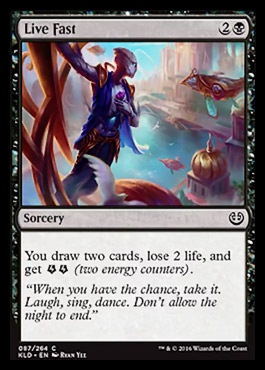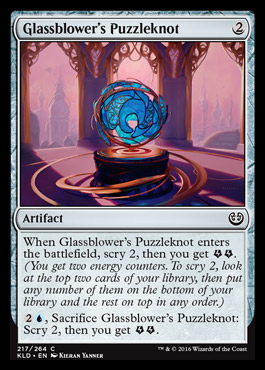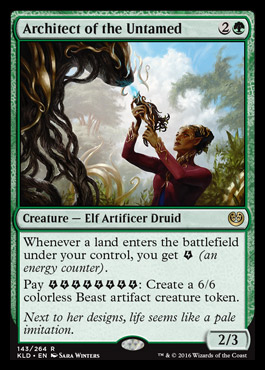[Carrie is off for the holidays for a well-earned vacation. In absence of a new article we’re revisiting the topic of drafting the Energy mechanic in Kaladesh. We don’t doubt that this will still hold true once Aether Revolt hits the scene in a few weeks. Enjoy this refresher on one of the block’s core mechanics, and have a happy New Year!]
Kaladesh is coming!
A week ago, that would sound meaningless to me. Sure, it’s the new set, and I bet it will be good. New Chandra. Whatever. As Zach put so eloquently on Tuesday, we’ve been inundated with too many consecutive set spoilers. They all kind of run together. Did they print Force of Will in Eternal Masters or in Conspiracy 2? Which one has Rishadan Port? Damnation? It’s hard to keep track these days.
But then I saw the early Kaladesh spoilers during the world championship broadcasts. And . . . wow. I cannot wait to draft Kaladesh. Bold prediction: Kaladesh will be one of the best draft formats of all time.
The moment I saw energy, I knew we were in for something big. There are going to be a lot of green energy revolution puns in the months to come—I’m hoping for an aggro energy deck in Standard that we can call Jeb!—but what I am about to say is not a pun. Energy is a revolutionary mechanic for limited. It reminds me of morph, and I expect it to be similarly awesome to draft.
That’s a bold statement.
Draft formats are defined by the available archetypes you can build. In most recent sets, these archetypes have been linked to the ten two-color pairs. The roles of each pair change slightly from set to set, but most of them don’t change much. Maybe white-red focuses on equipment, or tokens, but it tends to be a small aggressive creature deck. Black-red has both aggro and removal-control versions, and the relative power of the two shifts with each set. White-blue almost always takes to the skies. Sometimes sets like Khans of Tarkir or Theros will enable three-color or mono-color decks, but the broad strategies available are mostly static.
Energy can change that because it is a new “colorless” mechanic that is only partially available to each color. Artifacs and colorless spells allow for additional options in deck-building; but because they can go in any deck, the best ccolorless cards get taken early and the filler ones have little effect on deck quality. Energy can be mixed and matched across colors—you can use the two energy made by Live Fast for any use your deck can muster. Paired with red, the energy can add extra damage to spells or atacking creatures. Paired with other colors, plenty of other strategc options will be available once we see all the cards.
This means that energy cards make up sub archetypes that can fit into any color pair. It appears that all colors can both make and use energy, and there are artifacts that do as well. I expect that energy will open up many new options for drafting decks and lead to a more diverse draft metagame. Wizards R&D make great limited sets, and they are very aware of the limitations on how they can spread archetypes around the draft table. They always look for new ways to open design space, and energy is a brilliant solution.
It’s no coincidence that energy was first developed during Mirrodin block. It is effectively a new form of colorless mana. While it accumulates differently as a resource than mana does, energy is a resource you can spend for effects of any color. If a draft format has too many actual colorless cards, all decks homogenize around powerful cards that go in any deck. Powerful colorless cards avoid the major limitation on draft: you don’t have to play specific lands to cast those cards.
In Oath of the Gatewatch, Wizards tried to avoid this through “hard” colorless mana requirements. Colorless mana became a pseudo sixth color, but in practice, most Oath draft decks treated hard colorless mana as a splash for a few key spells. Therefore, they did not expand archetype options so much as impose a manabase cost on certain spells. Likewise, colored artifacts in Shards of Alara and New Phyrexia merely added artifact synergies to cards that would otherwise just have been colored spells. These methods allowed their draft formats to contain more artifacts or colorless spells, to build on set themes, but did not fundamentally alter the available archetypes in a draft.
Energy looks like it will offer a wide range of effects across the colors. I expect the set will offer many new strategic options. Mark Rosewater explained that energy helps create greater variance between games played with the same deck. It will also create greater variance between decks of the same colors. There will be heavy-energy decks and low-energy decks. A player’s energy counters will be a new metric to track during the game, and you will often have to guess what uses your opponent will have for the energy they generate. When deciding what to play around or plan against, you will have to consider their available energy in addition to mana. And when deciding how to bait your opponent into using their resources inefficiently, you will have to consider whether they have a big energy play late that you can cut off by forcing them to use energy early. As opposed to a card like Shrine of Burning Rage, where you know it will deal more damage the longer you wait and therefore you want to force them to use it early, with energy you might not know whether energy is building up to crush you or to be wasted.
The colorless-ness and uncertainty of how energy will be used explains why it reminds me of morph. Off-color morphs could fill out your creature curve and help mask powerful morphs like Kheru Spellsnatcher—if your opponent sees a morph you couldn’t flip in game one, they might not be suspicious of morphs you don’t flip in game two. Morph also helped smooth mana requirements by ensuring you can play a creature off any three mana, which enabled the three-color decks. Energy still requires colored mana play its spells (other than some artifacts), but you can still splash some powerful energy cards similar to how you might play one or two sources to flip an off-color morph. While the two mechanics have many differences, I expect them to have similar beneficial effects on the strategic depth of the format.
Energy adds complexity because we have a new resource to track. But it looks like R&D dialed down other complexity to make room. The three big mechanics of Kaladesh—energy, vehicles, and fabricate—all appear across the five colors (or are colorless) and offer great diversity. This is a change from sets with five or six niche mechanics that appear in only some colors. I believe three “universal” mechanics will be less complex than five-plus narrow mechanics. And this goes back to the change in draft archetypes: when R&D are stuck in the same ten two-color macro-archetypes, they have to create tricky and narrow mechanics to change how those archetypes play out. Think of surge from Magic Origins. It’s just another blue-red “spells matter” mechanic, and that’s pretty much all it added to the draft format. But with energy, they can make cards that generate and use energy to help cast more spells in a blue-red deck while also adding pump effects to small creature decks and card advantage to control decks.
Not only do we only have three named set mechanics, the other two besides energy are quite simple. Vehicles are very intuitive. We will have to learn the intricacies of crewing them and how they play in games, but I suspect that will come quickly and then vehicles will feel natural. Fabricate is just a new version of unnamed mechanics we’ve had before, like in Fate Reforged on cards like Sandsteppe Outcast. We alrady know how it works, but it may have more subtlety when available on many cards instead of just a few.
So that’s why I’m excited for Kaladesh and the energy revolution!
Carrie O’Hara is Editor-in-Chief of Hipsters of the Coast.




